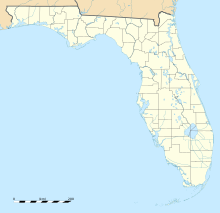Naval Air Station Sanford | |||||||||||||||
|---|---|---|---|---|---|---|---|---|---|---|---|---|---|---|---|
 A3D-2 (A-3B) Skywarriors of VAH-7, BuNo 138916 and Buno 142660, over NAS Sanford in the early 1960s | |||||||||||||||
| Summary | |||||||||||||||
| Airport type | Military | ||||||||||||||
| Owner | United States Navy | ||||||||||||||
| Location | Sanford, Florida | ||||||||||||||
| Elevation AMSL | 57 (now 55) ft / 18 (now 17) m | ||||||||||||||
| Coordinates | 28°46′40″N 081°14′15″W / 28.77778°N 81.23750°W | ||||||||||||||
| Map | |||||||||||||||
 | |||||||||||||||
| Runways | |||||||||||||||
| |||||||||||||||
Naval Air Station Sanford (IATA: NRJ, ICAO: KNRJ, FAA LID: NRJ) was a naval air station of the United States Navy in Sanford, Florida, approximately 20 miles north of Orlando, Florida. Opening less than a year after the start of World War II, NAS Sanford's initial function was as an advanced training base for land-based patrol bombers, followed by carrier-based fighter aircraft. The air station briefly closed in 1946 and was placed in caretaker status until being reactivated in 1950. It eventually served as a Master Jet Base for carrier-based heavy attack and reconnaissance aircraft until 1969. After its closure, it reopened as civilian general aviation airport under various names with a non-Navy civilian airport identifier (IATA: SFB, ICAO: KSFB, FAA LID: SFB) until finally transitioning to a scheduled air carrier airport under its current name of Orlando-Sanford International Airport.
